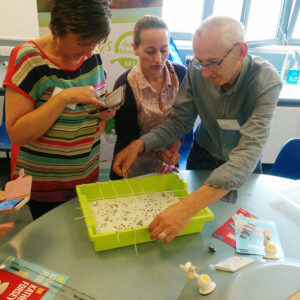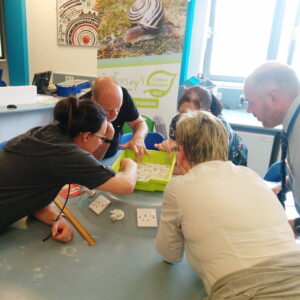Estimate
This activity was created as part of a Gratnells What’s In My Tray CPD workshop for secondary science teachers and technicians to support practical work and delivery of the curriculum. It can be carried out as a stand-alone activity for students or combined with other activities from the session to form a STEM carousel.
Develop or practice your ecological sampling techniques.


You will need (per team of 4):
- 1 x Shallow Gratnells (F1) tray with lid
- 1 x A3 acetate cut down to the same size as the bottom of the Gratnells tray per group
- 1 x Acetate pen
- 1 x 30cm ruler
- 1 x Small pack sticky tack
- Pieces of thin string pre-cut to the same size as the tray width and length sufficient to create a 5cm by 5cm string grid across the tray from rim to rim
- 1 x Cloth to wipe off the acetate sheet between teams
- 1 x Paper and pencil for making a note of their estimate
- 1 x Simple calculator
For preparation (only one rice tray needed, the same tray can used by all teams in the carousel):
- 1 x Shallow Gratnells (F1) tray with lid
- PVA glue
- White and black rice grains (wild rice grains are black)
- 1 x A3 card
This activity also works for individuals or smaller teams, just increase the amount of time allocated to complete it.
This activity can be repeated multiple times using the same rice tray. The rest of the equipment is reusable
Tip: A green or blue ink acetate pen makes the activity a little easier as a black ink may blend in with the black rice grains.
Preparation:
- Cut the A3 card down to the same size as the bottom of the shallow Gratnells (F1) tray and place it into the bottom of the tray.
- Cover the card in a thick layer of evenly spread PVA glue.
- Working quickly while the glue is still wet, sprinkle white rice grains over the glue to completely cover the card in a single layer of grains.
- Evenly sprinkle over a known number of black rice grains. Use 300-500 grains, adjusting the number depending on how difficult you want to make the activity. Again, ensure a single layer only, i.e. no big piles of rice grains.
- Allow the glue to dry so all the rice is fully stuck down.
- Put the lid on the tray and leave to one side until the start of the activity.
- Place the other equipment in to the second shallow Gratnells (F1) tray and put the lid on.
What to do:
- Approach the trays and lift the lid
- Use ecological sampling techniques to estimate the number of black rice grains but without disturbing them.
- You can use any or all of the equipment provided in the second tray but must not draw on or mark the rice grains. Do not try to remove any rice grains from the shallow tray.
- At the end of the allocated time, write your estimate down.
- Team closest to the real answer gets 5 points, next closest 4 points and so on. The answer will be revealed at the end of the session.
Tidy up time:
- If you have marked or drawn on the acetate, rub it clean using the cloth.
- Put the equipment back into the shallow tray.
- Replace both tray lids.
What is happening?
The equipment provided gives the participants two options for estimating the black rice grain population:
- Make a string grid of 5cm squares across the tray using the pre-cut string and the sticky tack. Count the number of black rice grains in several squares picked at random from across the grid, calculate the average number of rice grains per square and multiply this by the total number of squares.
- Draw a grid on the acetate sheet. Put the sheet down on top of the rice grains. Count the number of black rice grains in several squares picked at random from across the grid, calculate the average number of rice grains per square and multiply this by the total number of squares. The acetate sheet can also be used to mark the location of each black rice grain within a small number of squares and then lifted out of the tray and placed on a pale background for counting and cross-marking. This is a more accurate counting method as it ensures no grains are missed or counted twice.
For both methods, participants will have to decide which squares they are going to sample (count) because the time available for the activity (we use 5-6 mins per team for the CPD carousel) will not be long enough for them to count all black rice grains present in all squares.
TIP: Using a random number generator (available as a free App) to select the square from xy coordinates on the grid axis would be the most scientific way to select squares for sampling.
Other things to try:
To make the activity easier or quicker:
- provide equipment for only one method.
- set up the string grid and/or draw up the acetate grid in advance of the participants starting the activity.
- pre-label the x and y axis and inform the teams which squares they should sample in the instructions.
To make the activity more challenging:
- provide only a ball of string and some scissors, do not pre-cut the string.
Alternatives to rice:
Swap the black and white rice grains out for a wide variety of coloured spherical beads or flat coloured counters (think tiddly winks), of the same or differing sizes. The smaller and more varied the beads or counters, the more challenging the activity. Ask the participants to estimate the size of the ‘yellow population’ or ‘the larger species’ or ‘the red and yellow populations’ for further challenge. TIPS: count the beads or counters before you add them to the tray, so you know the answers in advance. Try to ensure an even or fully random distribution by mixing known quantities of each colour in a jar before pouring on to the glue.
Gratnells also make A3 and Art Trays, which are larger, and could be used for a giant version of this activity.
Health & Safety
As with all Gratnells Learning Rooms What’s In My Tray activities, you should carry out your own risk assessment prior to undertaking any of the activities or demonstrations.

